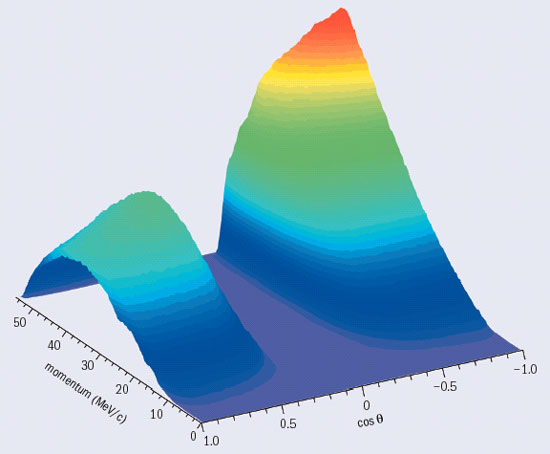Normal muon decay (μ+ → e+ νe νμbar) is an ideal process to investigate the electroweak interaction in the Standard Model. The reaction involves only leptons, obviating the need for uncertain strong-interaction corrections, thus making it a clean probe of the theory’s purely left-handed (V-A) structure. A high-precision determination of the parameters describing the muon-decay spectral shape explores physics possibilities beyond the Standard Model, for example involving right-handed interactions. The world’s most precise determination of these parameters has been the goal of the TRIUMF Weak Interaction Symmetry Test (TWIST) experiment. The collaboration has recently completed its first phase by directly measuring the muon-decay parameters ρ and δ, improving the Particle Data Group (PDG) values by factors of 2.5 and 2.9 respectively.

The distribution in energy and angle of positrons from polarized muon decay is described by the four “Michel parameters”. The spectrum’s isotropic part has a momentum dependence determined by ρ plus an additional small term that is proportional to a second parameter, η. The asymmetry is proportional to a third parameter ξ multiplied by the muon polarization, Ρμ, while a fourth parameter, δ, determines its momentum dependence. Within the Standard Model, these parameters are predicted to be ρ = ¾, δ= ¾,ξ = 1 and η = 0.
TWIST uses beams of positive muons as they can be produced with high polarization. The high-intensity TRIUMF proton beam produces π+, some of which decay at rest at the surface of a production target to create a highly polarized “surface” muon beam with momentum 29.6 MeV/c, which is subsequently transported into a 2 T superconducting solenoid.
Most of the muon beam stops in a thin target, located at the centre of a symmetric array of 56 low-mass, high-precision planar drift-chambers. Limitations on final errors are dominated by systematic effects since the statistical precision is very high. The measured momentum and angular distribution of the decay positrons are shown in the figure. The drop in acceptance near | cos (θ) | = 0 is because of the poor reconstruction efficiency in that region. To extract the muon-decay parameters, a 2D fit is made to a fiducial region where the detector acceptance is uniform, using a blind-analysis technique. The results are based on 6 x 109 muon decays, spread over 16 data sets. Four sets were analysed for both ρ and δ. A fifth set of low-polarized muons from pion decays in flight was also analysed for ρ. The remaining data sets, combined with further Monte Carlo simulations, were used to estimate the sensitivities to various systematic effects.
TWIST’s new measurement of ρ = 0.75080 ± 0.00032(stat.) ± 0.00097(syst.) ± 0.00023 (last uncertainty due to the current PDG error in η) sets an upper limit on the mixing angle of a possible heavier right-handed partner to the W boson, |ζ| <0.03 at 90% confidence level (c.l.). Combining ρ with the new measurement of δ = 0.74964 ± 0.00066(stat.) ± 0.00112(syst.), and the PDG value of Ρμξδ/ρ, an indirect limit is set on Ρμξ: 0.996 <Ρμξ< 1.004 with 90% c.l. The lower limit slightly improves the limit on the mass of the possible right-handed boson, WR ≥ 420 GeV/c2. Finally, an upper limit is found for the muon right-handed coupling probability, QμR< 0.00184 at 90% c.l.
Muon decay, combined with measurements from experiments at higher energies and in nuclear beta decay, helps our understanding of the asymmetry in the weak interaction’s handedness. In the future phases of the experiment, TWIST aims to produce a direct measurement of Ρμξ with a precision of a few parts in 104 and to increase its sensitivity to ρ and δ by approximately another factor of five.
Further reading
A Gaponenko et al. 2005 (in press) Phys. Rev. D hep-ex/0410045.
J R Musser et. al. 2005 Phys. Rev. Lett. 94 101805.
See also http://twist.triumf.ca.








